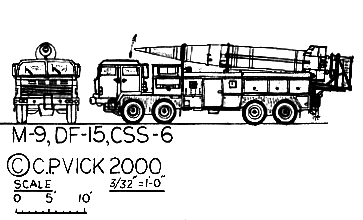





The DF-15 (CSS-6) , better known by the export name M-9, is a sophisticated solid-fueled, single-stage mobile missile, similar in appearance to the US Pershing I-A system. The M-series missiles all use solid fuel, and operational preparation time is short. The DF-15 is expected to be equipped with a variety of warhead types and to become the mainstay of China's sub-strategic missile force.
The vertically-launched 9.1 meter long missile has a range of 200-600 kms, carrying a payload of 500 kgs, with a CEP of about 280 meters. The missile uses a strapdown inertial guidance system on the warhead section which guides the trajectory using small thrusters. The missile body is designed to trail behind the separated warhead and provide camouflage for the warhead (which is only one-tenth of the size of the missile body). The DF-15 utilizes a Chinese-developed eight-wheel cross-country Transporter Erector Launcher [TEL] with both launch and transport capacities. These highly-mobile cross- country trucks have the capacity to launch the missiles. It is coordinated with advanced digital C3I computer system using digital computer-controlled technology and self-test functions to provide an operational preparation time of less than 30 minutes.
It has been suggested that in the future the DF-15 will be equipped with a global positioning system that is coordinated with a new-type ring-laser gyroscopic inertial-guidance system, coupled to a faster on-board computer system so as to increase the accuracy of the missile's end-segment guidance system to achieve a CEP of 30-45 meters. As the missile has a terminal velocity of over Mach 6 this system may be considered for deep-penetration strike requirements (against underground fortifications).
Developed in the 1980s, the DF-15 first appeared in the Beijing Defense Exhibition in 1988. And it is believed that by 1989 China had equipped the Second Artillery with a few of these missiles. China�s DF-15 road-mobile SRBM has been operational since 1995, with an initial force of 40 missiles. By the end of 1999 China had deployed 200 SRBMs and was increasing the force at a rate of 50 missiles per year. As of mid-2000 the PLA had one regimental-sized CSS-6 SRBM unit deployed in southeastern China. This CSS-6 unit was expected to be augmented by a CSS-7 SRBM unit and one additional CSS-6 unit.
DF-15 missiles were launched from southern China into the waters off Taiwan in 1995 (six or seven launches) and 1996 (four launches) as part of Beijing�s efforts to dissuade Taiwan from moving toward independence. These launches into specific closure areas near Taiwan demonstrated a degree of accuracy not previously associated with Chinese missiles.
Specifications |
|
| Contractor | Academy of Rocket Motors Technology - ARMT |
| Operator | Second Artillery Corps |
| Basing |
|
| Configuration | Single Stage |
| Length [meters] | 9.1 |
| Diameter [meters] | 1.0 |
| Mass [kilograms] | 6,200 |
| Propellant | Solid |
| Guidance | Inertial |
| First Flight | 198? |
| IOC | 1995 |
| Deployment | mobile |
| Range (km) | 600 |
| Re-entry Vehicle Mass (kg) | 500 |
| Warhead Yield | 50-350 KT or conventional |
| CEP (meters) | 300-600 | Launch Preparation Time | 30 minutes |

